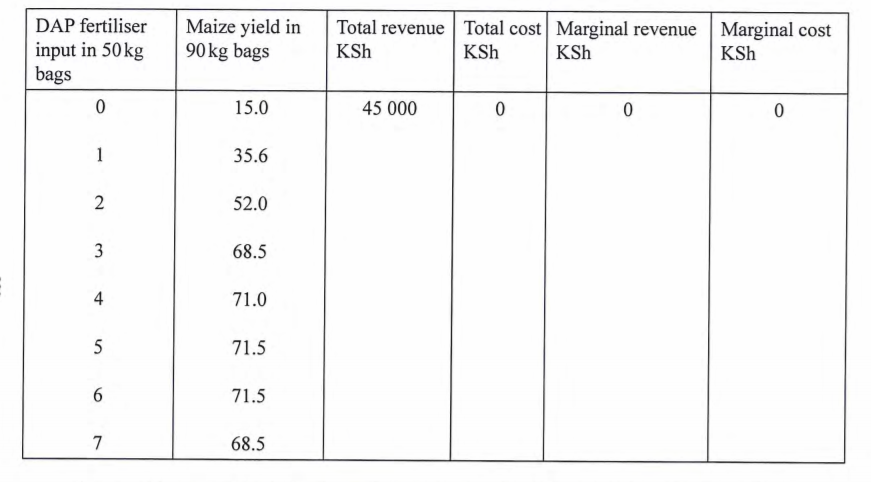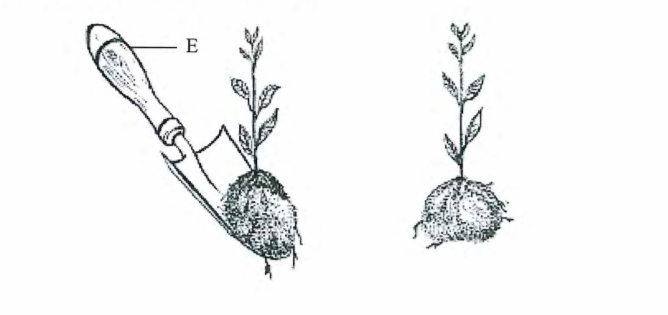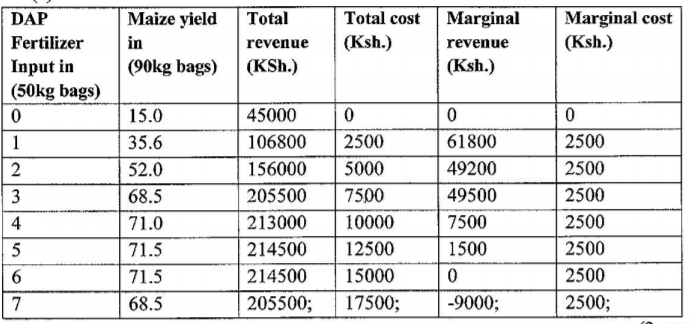2018 KCSE Agriculture Paper 1 Past Paper
SECTION A (30 marks)
Answer all the questions in this section in the spaces provided.
1.Name four categories of livestock farming.(2 marks)
2.State four farming practices that ensure minimum tillage.(2 marks)
3.State four factors that determine the choice of water pipes used on the farm.(2 marks)
4.Name two sources of underground water.(1 marks)
5.Give four reasons why green manure is not commonly used in farming.(2 marks)
6.(a) Name two types of inventory records kept on the farm.(1 mark)
(b) State two uses of inventory records on a farm. (1 mark)
7.(a) Name three vegetative planting materials used for propagating pineapples. (1½ marks)
(b) State three qualities of certified seeds. (1½ marks)
8. State four advantages of using polythene sleeves to propagate stem cuttings.(2 mark)
9. State four disadvantages of concession land tenure system.(2 mark)
10. Name four insect pests of beans in the field.(2 marks)
11. (a) Name three legume pastures grown in high altitude areas. (l½ marks)
(b) State four management practices undertaken to improve natural pastures. (2 marks)
12. (a) Name two subsidiary books of the journal.(1 mark)
(b) State four item details contained in a sales receipt.(2 mark)
13. State four roles of Young Farmers Clubs in Kenya.(2 mark)
14. (a) What is meant by the term agroforestry? (½ mark)
(b) Name two agroforestry practices.(2 mark)
SECTION B (20 marks)
Answer all the questions in this section in the spaces provided.
15. The diagram below shows a section of a plant from which the planting material illustrated was obtained.

(a) Identify the planting material illustrated. (1 mark)
(b) Give two reasons why only the middle part of the plant was used to prepare the planting material. (2 marks)
(c) Apart from using the middle part of the plant, explain two precautions that should be observed when preparing the illustrated planting material. (2 marks)
16. An experiment was carried out to investigate soil constituents as described below:
Step I — An empty evaporating dish was weighed and its mass was 10 gms.
Step II — Fresh garden soil was put on the evaporating dish and weighed. The mass was 40 gms.
Step III — The evaporating dish containing fresh soil was put in an oven and heated at a temperature of 105 °C for 30 minutes, cooled and then weighed.
The mass was 35 gms.
Step IV — The dish containing soil was then strongly heated on a Bunsen burner for two hours while stirring. It was then cooled and weighed. The new mass was 32 gms.
(a) Give a reason why the soil was heated
(i) at 105 °C
(ii) strongly for two hours
(b) Calculate the percentage content of the soil constituents investigated in the experiment. (3 marks)
17. The diagram below illustrates a nursery practice.
(a) Name the practice
(b) Give a reason why the tool labelled E is important in the practice illustrated. (1 mark)
(c) What is the appropriate stage of growth for carrying out the illustrated practice in agroforestry? (1 mark)
(d) Explain two activities that ensure that the illustrated practice is carried out successfully.(2 marks)
18. In a maize production enterprise carried out over a period of eight years, a farmer used one hectare of land each time and applied different quantities of DAP fertiliser.
DAP fertiliser costs KSh 2 500 per 50kg bag and the harvested maize is sold at KSh 3 000 per 90kg bag. The quantities of DAP fertiliser applied and maize harvested are as shown in this table below.

(a) Complete the table by determining the values of total revenue, total cost, marginal revenue and marginal cost. (2 marks)
(b) From the information in your table, how can the farmer determine the level of production at which profit is maximum? (1 mark)
(c) At the production level that yielded maximum profit, what was the value of each of the following?
(i) DAP fertiliser input(1 marks)
(ii) Marginal revenue(1 marks)
SECTION C (40 marks)
Answer any tiro questions from this section in the spaces provided after question 21.
19. (a) Explain six farming practices that destroy soil structure. (6 marks)
(b) (i) State four functions of calcium in plant growth. (4 marks)
(ii) State four disadvantages of using inorganic fertilisers in crop production. (4 marks)
(c) Describe six categories of pesticides based on mode of action.(6 marks)
20. (a) Explain six cultural methods of soil and water conservation.(6 marks)
(b) Explain four environmental factors that influence effectiveness of herbicides.(8 marks)
(c) Describe six post-harvest practices for dry beans.(6 marks)
21. (a) (i) Describe the harvesting and marketing of bulb onions.(6 marks)
(ii) State the precautions that should be observed when harvesting cotton.(4 marks)
(b) Explain five problems associated with agricultural credit.(5 marks)
(c) Explain five principles that govern the formation and functioning of farmer’s co-operatives.(5 marks)
2018 KCSE Agriculture Paper 1 Past Paper-Marking Scheme/Answers
SECTION A (30 marks)
Kenya certificate of primary Education
2018 Agriculture Paper 1
SECTION A (30 marks)
Answer all the questions in this section in the spaces provided.
1.Name four categories of livestock farming.(2 marks)Pastoralism; Fish farming; Apiculture; Poultry rearing;
2.State four farming practices that ensure minimum tillage.(2 marks)Application of herbicides; Mulching; Timing cultivation; Restricted cultivation to planting areas; Cover cropping; Uprooting/slashing
3.State four factors that determine the choice of water pipes used on the farm.(2 marks)Strength of the pipes; Amount of water to be conveyed; Cost of the pipe; Diameter/size of the pipe; Durability; Colour of the pipes;
4.Name two sources of underground water.(1 marks)Springs Wells; Boreholes
5.Give four reasons why green manure is not commonly used in farming.(2 marks)Manure crop may exhaust soil moisture at the expense of the main crop; Nutrients are used by micro-organisms to decompose the green manure; Green manure crops and food crops; Decomposition takes long;
6.(a) Name two types of inventory records kept on the farm.(1 mark)Permanent goods inventory; Consumable goods inventory;
(b) State two uses of inventory records on a farm. (1 mark)Determine the goods to acquire and replace; Detect theft and loses on the farm; Show assets owned by the farm;
7.(a) Name three vegetative planting materials used for propagating pineapples. (1½ marks)Suckers; Crowns; Slips
(b) State three qualities of certified seeds. (1½ marks) High germination percentage; Free from pests and diseases; Suitable to the ecological conditions; Free from physical damage; True to type; Clean;Minimize root damage during transplanting; Easy to transport seedlings; Seedlings establish faster; Easy to control soil borne pests and diseases; Allows transplanting to occur when conditions are suitable; Easy to trim roots awaiting transplanting;
9. State four disadvantages of concession land tenure system.(2 mark)Company may engage in monopolistic practices; ln case of inefficiency, heavy losses occur; Proceeds may only benefit the mother country of the company; Poor management leads to labour and social problems;
10. Name four insect pests of beans in the field.(2 marks)Bean aphids; Bean bruchid; American bollworm; Bean fly; Golden ring moth; Bean thrips;
11. (a) Name three legume pastures grown in high altitude areas. (l½ marks)Lucerne; Silver leaf desmodium; Green leaf desmodium; Stylo; Kenya White Clover; Purple veteh
(b) State four management practices undertaken to improve natural pastures. (2 marks)
Weed control; Topping; Over sowing with leguminous pastures; Fertilizer application; Irrigation; Pest control;
12. (a) Name two subsidiary books of the journal.(1 mark) Purchase book; Sales book
(b) State four item details contained in a sales receipt.(2 mark)Item description; Cost per each item; Quantity purchased; Amount paid for each item; Discount allowed;
13. State four roles of Young Farmers Clubs in Kenya.(2 mark)Participating in exhibitions at ASK shows; Undertaking agricultural projects at school level; Participating in YFC annual rallies; Participating in national tree planting activities; Involvement in exchange programmes; Participations in national ploughing contests; Involvement in workshops/seminars related to agriculture;
14. (a) What is meant by the term agroforestry? (½ mark)Practices of growing trees/shrubs together with crops/fodder crops and keeping livestock on the same piece of land;
(b) Name two agroforestry practices.(2 mark)Alley cropping; Multi-storing cropping; Wood lots;
SECTION B (20 marks)
Answer all the questions in this section in the spaces provided.
15. The diagram below shows a section of a plant from which the planting material illustrated was obtained.

(a) Identify the planting material illustrated. (1 mark)Top parts tend to rot when planted; Bottom takes long to root;
(b) Give two reasons why only the middle part of the plant was used to prepare the planting material. (2 marks)Place it in water until it is planted to prevent dehydration. Each cutting should have a leaf and a bud for photosynthesis and establishment respectively; Use a sharp knife or blade to prevent breaking of the cutting; Make slanting cuts to prevent accumulation of moisture;
(c) Apart from using the middle part of the plant, explain two precautions that should be observed when preparing the illustrated planting material. (2 marks)Place it in water until it is planted to prevent dehydration. Each cutting should have a leaf and a bud for photosynthesis and establishment respectively; Use a sharp knife or blade to prevent breaking of the cutting; Make slanting cuts to prevent accumulation of moisture;
16. An experiment was carried out to investigate soil constituents as described below:
Step I — An empty evaporating dish was weighed and its mass was 10 gms.
Step II — Fresh garden soil was put on the evaporating dish and weighed. The mass was 40 gms.
Step III — The evaporating dish containing fresh soil was put in an oven and heated at a temperature of 105 °C for 30 minutes, cooled and then weighed.
The mass was 35 gms.
Step IV — The dish containing soil was then strongly heated on a Bunsen burner for two hours while stirring. It was then cooled and weighed. The new mass was 32 gms.
(a) Give a reason why the soil was heated
(i) Get rid of soil moisture;
(ii) Destroy soil organic matter;
(b) Calculate the percentage content of the soil constituents investigated in the experiment. (3 marks)
(i) at 105 °C
(b) Water — Fresh soil — 40gms — l0gms
— 3Ogms;
– Dry soil — 35gms — l0gms
= 25gms
– Water = 30 — 25
= 5gms
% of water = 5 x 100 = 16.6667%; 30
Organic matter — 25 — 22
=3
% of organic matter = 3 x100
30
10%
17. The diagram below illustrates a nursery practice.

(a) Name the practice(1 marks)Transplanting;
(b) Give a reason why the tool labelled E is important in the practice illustrated. (1 mark)It ensures a seedling is lifted with a ball of soil around the roots;
(c) What is the appropriate stage of growth for carrying out the illustrated practice in agroforestry? (1 mark)After 6 -12 months
(d) Explain two activities that ensure that the illustrated practice is carried out successfully.(2 marks)Watering before lifting the seedling; Planting at the same depth it was in the nursery; Shading; Watering; Mulching; Protection;
18. In a maize production enterprise carried out over a period of eight years, a farmer used one hectare of land each time and applied different quantities of DAP fertiliser.
DAP fertiliser costs KSh 2 500 per 50kg bag and the harvested maize is sold at KSh 3 000 per 90kg bag. The quantities of DAP fertiliser applied and maize harvested are as shown in this table below.

(a) Complete the table by determining the values of total revenue, total cost, marginal revenue and marginal cost. (2 marks)

(b) From the information in your table, how can the farmer determine the level of production at which profit is maximum? (1 mark)At the stage where marginal revenue is equal or almost equal to marginal cost;
(c) At the production level that yielded maximum profit, what was the value of each of the following?
(i) DAP fertiliser input(1 marks)5 bags
(ii) Marginal revenue(1 marks)KSh. 1500
SECTION C (40 marks)
Answer any two questions from this section in the spaces provided after question 21.
19. (a) Explain six farming practices that destroy soil structure. (6 marks)
Use of heavy machinery creates hardpans; Over cultivation which over pulverizes soil; Cultivating very wet soil using heavy Machinery creates hardpans; Deforestation destroys SOi1 cover; Overstocking destroys soil cover; Burning cracks the soil and destroys soil cover; Continuous cropping over pulverizes soil;
(b) (i) State four functions of calcium in plant growth. (4 marks)Elongation of apical meristems; Protein synthesis; Formation of middle lamellae Cell division; Strengthens plant cell walls;
(ii) State four disadvantages of using inorganic fertilisers in crop production. (4 marks) Easily leached; Some have scotching effects; Some are corrosive to users; Some inhibit soil microbial activities; Some change/alter soil pH.
(c) Describe six categories of pesticides based on mode of action.(6 marks)Stomach poisons which impair the digestive system of the pest; Systematic poisons which spread to the entire body of the pest and impair it; Contact poisons destroy the parts of the pest which come into contact with the pesticide; Suffocants deprive the pest of air; Anti-feedants impair the feeding mechanisms of the pest; Repellants make the pest to avoid the plant;
20. (a) Explain six cultural methods of soil and water conservation.(6 marks) Grass strips/filter strips; These are narrow uncultivated strips along the contour left between cultivated strips. Cover cropping; The establishment of a crop that spreads out over the surface of the soil to provide it with a cover. Contour farming; Carrying out all land operations along the contour. Mulching; Covering of the soil with either organic or synthetic materials. Crop rotation that involves the use of cover crops Correct spacing to ensure adequate soil cover Inter-cropping ensures the soil is adequately covered Ridging/furrowing to prevent surface runoffs and accumulate water Controlled grazing; Proper stocking rate, rotational grazing to ensure soil cover is not depleted. Strip cropping; Growing crops which give little ground cover in alternate strips with crops such as beans which have a good ground cover. Afforestation growing of trees where non-existed. Re-afforestation – growing of trees where they have been cut down. Agroforestry – land use that involves the growing of trees in combination with crops and pastures on the same piece of land.
(b) Explain four environmental factors that influence effectiveness of herbicides.(8 marks)Wind which deflects herbicides to unwanted areas; Rain which may wash away the herbicide from the weeds; Soil should be moist soak the herbicides to have prolonged effects on weeds; Light should of high intensity to optimize the uptake of the herbicide; Temperature should be optimum to cnsure that the weeds are physiologically active;
(c) Describe six post-harvest practices for dry beans.(6 marks)Threshing to seed seeds from pods; Drying to reducc the moisture content of the seeds; Cleaning to separate seeds from husks; Sorting to separate the different qualities; Grading to fix prices/value to the different qualities to facilitate marketing; Dusting to protect the crop from storage pests; Packaging in different units e.g. bags, packets, to facilitate storage and marketing;
21. (a) (i) Describe the harvesting and marketing of bulb onions.(6 marks)Harvested after 4 — 5 months/when leaks start to dry; Bent the tops of the neck; Dig up the bulbs; Put the bulbs under shade to dry; Turn the bulbs to ensure uniform drying; Grade the bulbs according to SlzC; Put bulbs in slatted boxes; Marketed in net bags;
(ii) State the precautions that should be observed when harvesting cotton.(4 marks)Avoid mixing cotton with foreign matter; Do not pick when wet; Do not use sisal bags; Pick balls that are fully open; Use separate bags for the grades AR (Safi) and BR (Fifi
(b) Explain five problems associated with agricultural credit.(5 marks)Lack of collaterals; Diversion of loans to other uses; High interest rates; Assets used as collaterals may be auctioned for non-repayment; Lack of lcnowledge/skills to manage finances; Lack of proper record keeping;
(c) Explain five principles that govern the formation and functioning of farmer’s co-operatives.(5 marks)Open membership; Equal rights; Principle of share limit; Interest on sharcs; Withdrawal from membership; Loyalty; Education; Co-operative principle; Non-profit motive;

